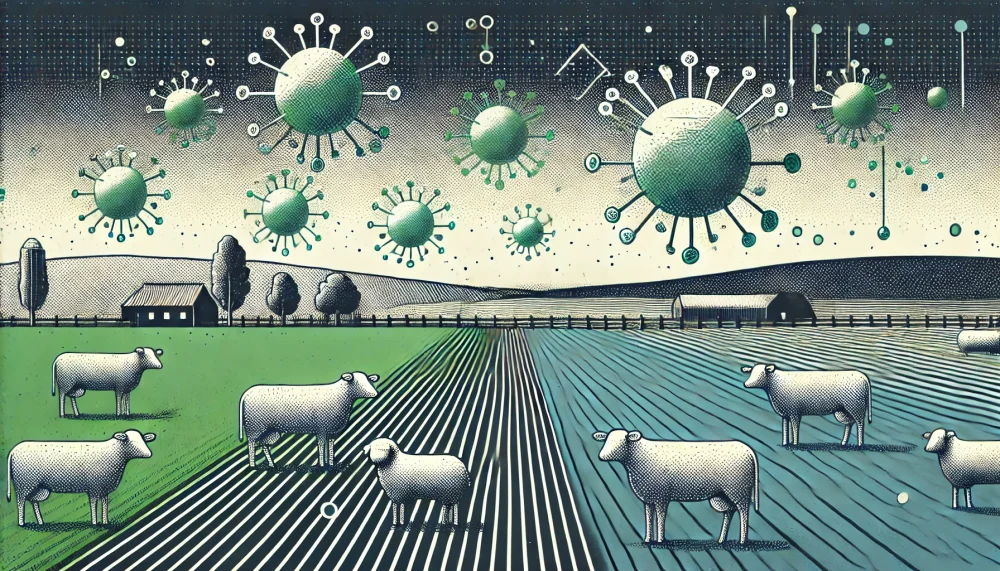Internal metric of space is influenced by geometry...
New Nature paper reveals that brain perceives distance differently depending on surroundings

The WHO defines zoonosis as any disease or infection naturally transmitted from vertebrate animals to humans. It is important to note that infections are explicitly transmitted from vertebrate animals because pathogens are transmitted from invertebrate animals, such as snails, or “jump” from one kingdom to another— for example, when plant pathogens become dangerous to humans. Zoonoses constitute a significant proportion of new and existing human diseases, although we typically start discussing zoonoses when transmission to humans has occurred relatively recently.
The transfer of a pathogen to humans from another kingdom usually happens either with individuals with immunodeficiency or under unusual conditions. A major scandal erupted in the United States when a facility producing spinal anaesthesia medication was located in a former railroad station next to a waste processing plant. As a result, sterility could not be ensured, and patients in several hospitals received a solution prepared under non-sterile conditions, which contained a fungus that parasitizes corn. If this fungus is introduced into a person’s cerebrospinal fluid, it begins to multiply there. Thus, an unexpected pathogen jump from plants to humans occurred.
Many infections that are zoonoses today are perceived more as diseases transmitted from human to human; we often forget that some diseases originated as zoonoses. A classic example is HIV infection, which is now considered a disease transmitted from person to person, and no one thinks about sanitizing, that is, trying to clear the infection reservoir.
Molecular-genetic studies show that the natural host of a close relative of HIV-1 group M is simian immunodeficiency viruses, which naturally infect chimpanzees. Another variant of the virus, HIV-2, lives in another type of monkey, the mangabey. Thus, one virus jumped from chimpanzees and the other from mangabeys. It is believed that this occurred in the early 20th century, most likely in the Cameroon region, and then spread from person to person. The single jump happened through human contact with a wild animal while butchering chimpanzees or eating meat.
Sometimes, besides the reservoir, there is an intermediate amplifying species, not the natural host, where the pathogen begins to multiply significantly faster. For instance, civets became the amplifying species for the first SARS-CoV, which spread in 2003: it is now believed that the virus jumped to them from bats. It should be understood that one of the indicators of wealth in China became the ability to eat wild animals. Since catching them is difficult and they need to grow under the right conditions, an industry of breeding them emerged. When the SARS epidemic began in China, the authorities ordered the destruction of all civets bred on farms. However, it later turned out that civets were only intermediate hosts, and the fight against zoonoses needed to identify the natural host.
An example of a zoonosis with a known natural host is rabies. Rabies in humans is preventable. It is one of the first zoonotic diseases for which vaccines were developed, and if treatment begins before symptoms appear, the person can be cured. However, if treatment starts after symptoms appear, the mortality rate is about 100%. For rabies prevention, hunters with high exposure to rabies can be vaccinated, and domestic animals, like dogs, which are natural hosts for the rabies virus, can also be vaccinated. Of course, the rabies virus lives in other animal species, but for modern urban residents, feral dogs are one of the critical sources of the virus.
The classic path of zoonosis spread, especially if the zoonosis is a new disease, looks like this. Zoonosis usually appears in wild animals: such an animal is its natural host, the reservoir. From this reservoir, the pathogen jumps to another species; that is, it makes an interspecies transition, and quite often, it transitions to domestic animals, as humans have more frequent contact with domestic animals than with wild ones. Some zoonoses directly transition from wild animals to humans. However, there is often an intermediate host: an utterly wild animal, a domestic animal, or a wild animal bred on a farm. The infection arises in such an animal, then the pathogen is transmitted to humans.
Most often, in wild animals, the infection is not very pronounced. The natural host is usually in symbiosis with the pathogen: from the pathogen’s point of view, killing all hosts is quite a stupid idea because then it would have nowhere to live. The first SARS outbreak burned out precisely because the mortality rate was relatively high—higher than that of SARS-CoV-2. Accordingly, the natural host should carry the infection quickly and not have any symptoms. Then the virus jumps to a domestic animal, which may carry the infection quite severely, and then to a human, who may also have a severe disease course. If a person carries the disease not too severely or if the incubation period, like that of HIV infection, is long enough, the zoonosis has the opportunity to start being transmitted from person to person and establish itself in the human population.
The most common zoonoses are campylobacteriosis, mainly transmitted through food; salmonellosis, contracted from raw eggs; brucellosis, contracted from the unpasteurized milk of infected cows and goats or direct contact with sick animals; leishmaniasis, transmitted by bites of infected sandflies; and bovine tuberculosis, most commonly contracted from drinking unboiled milk from infected animals.
If a vaccine exists for a disease, it is indeed possible to vaccinate domestic pets. However, vaccines are not available for all diseases. Infectious diseases are typically divided into vaccine-manageable and those for which a vaccine cannot be developed. Accordingly, for some animal diseases that can transition to humans, we can only fight them by modifying human behaviour and personal hygiene and maintaining hygiene in places where agricultural animals are kept. There are specific veterinary requirements for vaccinating animals kept together, and if a vaccine exists, it is more profitable for agricultural business owners to prevent the development of the disease. For example, avian influenza originated in waterfowl and then jumped to chickens and humans. Since avian influenza had a severe course with relatively high mortality, authorities, particularly in Hong Kong, culled one and a half million chickens: it is more profitable for business owners to prevent such a situation than to suffer the consequences.
Zoonoses are an essential source of health issues, mainly in places where there is close contact with wild or agricultural domestic animals. New diseases are often zoonoses, but finding the primary host in the wild forest is difficult. Despite the media’s attention to new diseases, old diseases like rabies remain a severe public health problem.
This article is part of the “One Health” guide, partnered with the biopharmaceutical company MSD Animal Health.

New Nature paper reveals that brain perceives distance differently depending on surroundings

Molecular biologist Greg Towers on the great scientific challenges, the dangers of gene therapy, and the way i...

Astrobiologist Christopher Carr on the Late Heavy Bombardment, deinococcus radiodurans, and the polymerase cha...